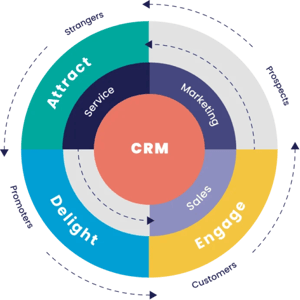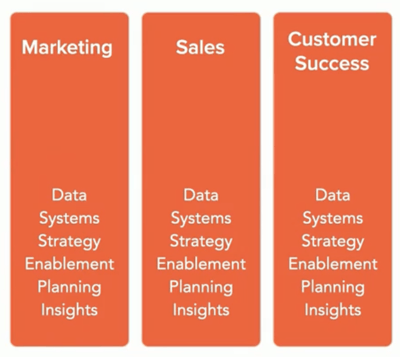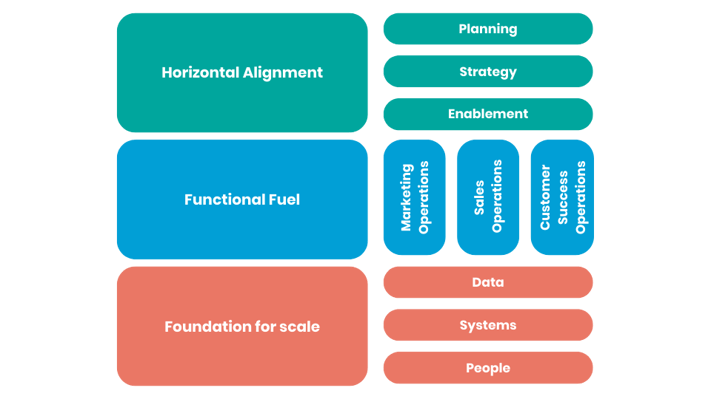





%20(7).png?width=560&name=Blackbird%20(600%20%C3%97%20340px)%20(7).png)
At Inbound 2022, Alison Elworthy (HubSpot) and Sid Kumar (HubSpot) delivered a presentation on how a RevOps framework should be adopted by organisations to experience successful scale.
Alison began by sharing HubSpot’s definition of RevOps.
“The operating system to power delightful customer experiences”
HubSpot’s RevOps Journey
Originally, HubSpot’s internal team found that there was no unifying force to pull together the end-to-end customer experience. Customers were experiencing a disjointed journey with multiple hand-offs.
Today, they are still learning as they go.
But, what HubSpot has realised is that RevOps is accelerating the flywheel and removing friction. And if you know HubSpot’s value proposition… that all sounds pretty aligned.
Prior to implementing RevOps at HubSpot, the CRM platform was experiencing silos. Teams had different KPIs and different goals.
There were separate teams for everything - from marketing to sales, customer success, and across operations.
HubSpot needed a new revenue growth strategy.
HubSpot’s Go To Market model
The Flywheel
The Flywheel model is designed to drive business growth and delight customers
RevOps is responsible for acting as the Flywheel’s operating system to accelerate revenue growth and unlock productivity at scale. Revops fuels the flywheel.

How HubSpot implemented a RevOps strategy
HubSpot’s GTM model pre-RevOps
Prior to implementing RevOps, HubSpot had separate vertical teams for marketing, sales and customer success. As the organisation scaled, HubSpot identified that there was a need for operations within each team.
Under each vertical pillar, traditional operations functions - people within data, systems, strategy, enablement, planning and insights - were still required.

Source: HubSpot
But, over time, HubSpot released that this approach was causing siloes. Teams were using different data, systems, KPIs and different strategies.
HubSpot’s GTM model with Revops.
The key to HubSpot’s RevOps strategy was to build three, horizontal pillars.
First up, the base layer.
The base layer is the single foundation for your systems, data and people.
Systems - HubSpot had different tools for different departments that didn't work well together. And as a result, there was misalignment. The key takeaway here: Your systems need to be connected.
Data - HubSpot's teams had isolated data and different KPIs. Key takeaway: Your teams need to be able to see the same data, in the same way, to truly understand and respond to the needs of the customer.
People - Your team must be aligned around single goals and targets.
Next, “Functional fuel”
The organisation still needed to maintain deep domain expertise and business acumen. By adding a RevOps leader and operations team to each functional fuel department, the people could be true COO for marketing, sales and Customer success teams.
Last, Horizontal alignment
HubSpot’s goal was to solve for the customer and create a unified customer experience. They needed to develop a horizontal strategy to delight the customer across their entire journey.

HubSpot’s RevOps mission statement
“Accelerating the path to revenue growth by driving breakthrough productivity (Efficiency X Effectiveness) and innovation for our flywheel teams.”
You want to break linear growth.
What is linear growth?
As organisations add resources and sales reps, revenue will traditionally scale.
Breaking linear growth
But organisations need to be more efficient with the resources they have.
How to bring together MarketingOps, SalesOps, and CSOps into a singular RevOps function.
Talent & People
RevOps is a shift towards empowering your people to become strategic business partners with the business. Your organisation needs to develop a strategy for hiring, progressing, and keeping talent.
HubSpot has placed a strong focus on its recruitment and development programs.
Systems
Systems and data are the "oil in the engine" - what data and analytics do you need across our customer journey? How are you engaging with our customers? And how do you continue to improve?
How does HubSpot achieve this? To state the obvious… they run on their own platform. HubSpot uses HubSpot.
But they also look at the surrounding tech stack. Connectivity is a core part of implementing a RevOps structure and integrations give you the ability to connect and align your data across all of your tech stacks.
Functional fuel
These are the strategy and operation functions across a go-to-market plan.
HubSpot thinks of these teams as the COOs of the business across marketing, sales and customer success. They connect insight to action.
When looking at the capabilities across your functional fuel teams, they should all possess planning, strategy, and enablement skills.
Planning
Create an integrated plan across your go-to-market teams. You should plan for demand, how your sales team operates, and the customer success journey. You need to plan what is in-scope and out-of-scope.
Strategy
Where do you want to be in 3-5 years from now? What investments do you need to make now to achieve your organisation's 5-year plan?
Enablement
How do you keep your people apprised of the latest developments, and your product’s solutions? How do you connect those to customer outcomes?
HubSpot's RevOps playbook
Clarity, Consistency, Capabilities
Clarity
Your entire organisation should have an understanding of:
- Their roles and responsibilities
- The customer journey
- The engagement points
- How to measure success at each point of the customer journey.
Consistency
You need to drive consistent execution.
- Create repeatable processes that you can achieve at scale
- Engage in dynamic planning
- Planning and execution go hand-in-hand.
Capabilities
The new capabilities in addition to people and processes that drive non-linear growth
- You need to drive real-time insights and create common definitions
- Where can you introduce automation and where do you need person-to-person interaction
- Create a connected technology stack
- Create agility - make changes without disrupting your go-to-market organisation








